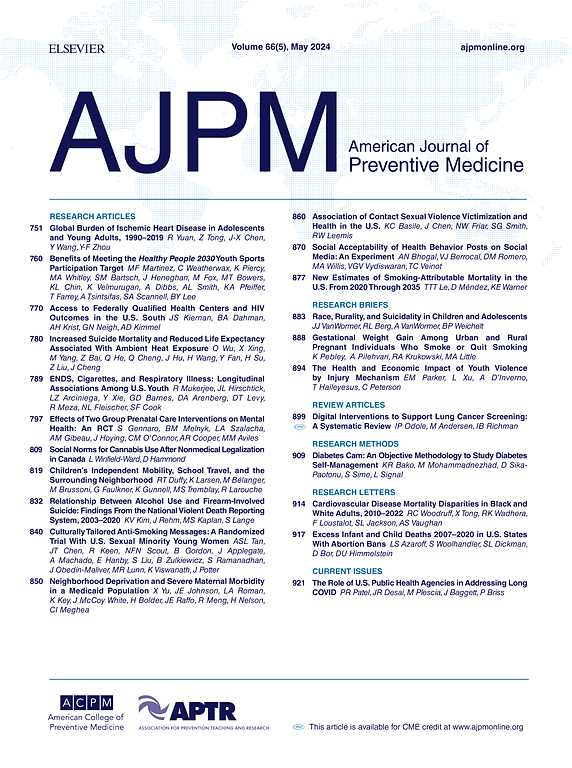Accountability and Funding for State-Level School Physical Education and Recess Laws
IF 4.5
2区 医学
Q1 MEDICINE, GENERAL & INTERNAL
引用次数: 0
Abstract
School physical education and recess provide important opportunities to increase youth physical activity and socioemotional development. However, compliance with existing laws is low at the elementary level. Reported barriers to law implementation include limited accountability and funding. However, the number of state physical education and recess laws that stipulate accountability and/or funding remains unknown. This cross-sectional review of active U.S. state-level laws related to public elementary school physical education and recess was conducted between October and December 2024. The Classification of Laws Associated with School Students and the National Association of State Boards of Education databases, along with web searches, were used to identify laws. Laws were double coded for inclusion of accountability- and funding-related language. Forty-nine U.S. states (96.1%) had physical education laws, and 22 (43.1%) had recess law; 21 (41.2%) had both. Among states with physical education law, 12 (25.5%) and 1 (2.0%) included language on accountability and funding, respectively. Among states with recess laws, 5 (22.7%) included language related to accountability, and none contained funding-related language. State-level physical education and recess legislation is highly prevalent, but most laws do not contain accountability-related language; virtually none contain funding-related language, which may be inhibiting implementation and driving inequities in related health outcomes. Additional research examining the relationship between accountability and funding language in physical education and recess laws and the degree of implementation of the laws is necessary to help inform the development of stronger laws to support the provision of quality physical education and recess in schools nationally.
州级学校体育和课间休息法的问责制和资金。
学校体育和课间休息为促进青少年体育活动和社会情感发展提供了重要的机会。但是,对现行法律的遵守程度在初级水平上很低。据报告,法律执行方面的障碍包括问责制和资金有限。然而,有多少州的体育和休会法规定问责制和/或资金仍然未知。这项横断面审查是在2024年10月至12月期间对美国现行的与公立小学体育和休息有关的州级法律进行的。与学校学生相关的法律分类和全国州教育委员会协会数据库,以及网络搜索,被用来识别法律。法律是双重编码的,包括与问责制和资金有关的语言。美国49个州(96.1%)有体育锻炼法,22个州(43.1%)有休会法;21人(41.2%)两者皆有。在有体育法的州中,分别有12个州(25.5%)和1个州(2.0%)加入了关于问责制和资金的规定。在有休会法的州中,有5个州(22.7%)包含了与问责有关的语言,零个州包含了与资金有关的语言。州一级的体育和休会立法非常普遍,但大多数法律不包含与问责相关的语言;几乎没有一个包含与资金有关的语言,这可能会阻碍执行并导致相关健康结果方面的不公平现象。有必要进一步研究体育和课间休息法中的问责制和资助语言与法律实施程度之间的关系,以帮助制定更强有力的法律,以支持全国学校提供高质量的体育和课间休息。
本文章由计算机程序翻译,如有差异,请以英文原文为准。
求助全文
约1分钟内获得全文
求助全文
来源期刊

American Journal of Preventive Medicine
医学-公共卫生、环境卫生与职业卫生
CiteScore
8.60
自引率
1.80%
发文量
395
审稿时长
32 days
期刊介绍:
The American Journal of Preventive Medicine is the official journal of the American College of Preventive Medicine and the Association for Prevention Teaching and Research. It publishes articles in the areas of prevention research, teaching, practice and policy. Original research is published on interventions aimed at the prevention of chronic and acute disease and the promotion of individual and community health.
Of particular emphasis are papers that address the primary and secondary prevention of important clinical, behavioral and public health issues such as injury and violence, infectious disease, women''s health, smoking, sedentary behaviors and physical activity, nutrition, diabetes, obesity, and substance use disorders. Papers also address educational initiatives aimed at improving the ability of health professionals to provide effective clinical prevention and public health services. Papers on health services research pertinent to prevention and public health are also published. The journal also publishes official policy statements from the two co-sponsoring organizations, review articles, media reviews, and editorials. Finally, the journal periodically publishes supplements and special theme issues devoted to areas of current interest to the prevention community.
 求助内容:
求助内容: 应助结果提醒方式:
应助结果提醒方式:


